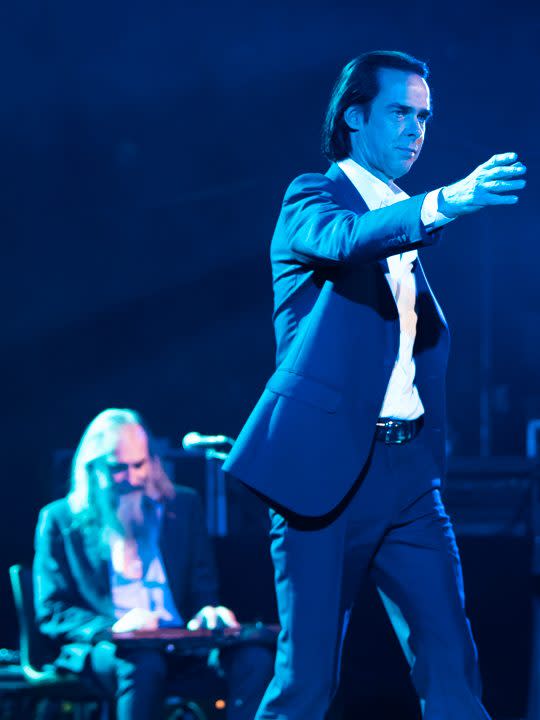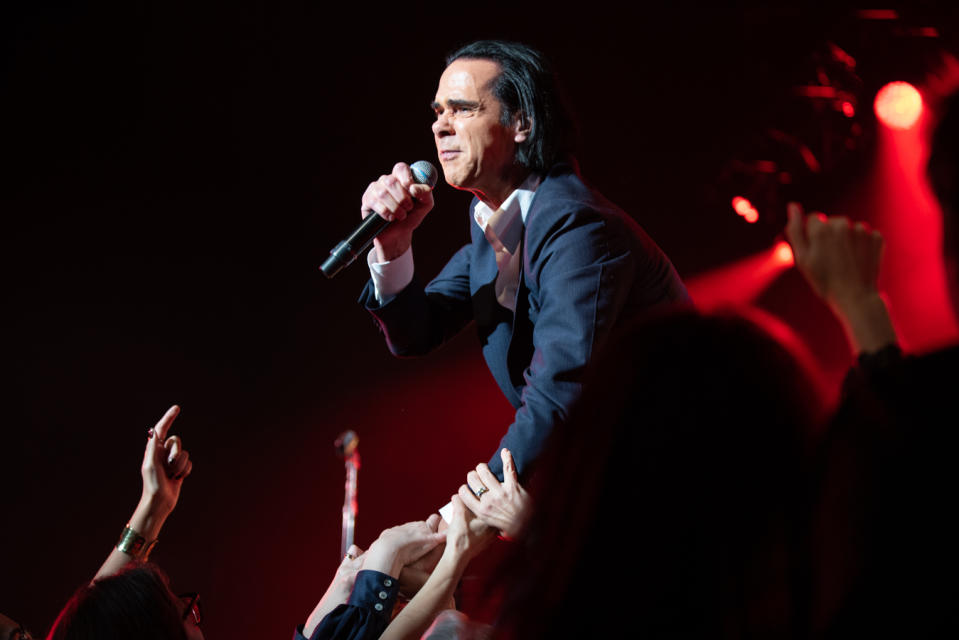The Agony, Then Ecstasy, of Nick Cave: Collaborators Tell How ‘Communion’ With His Audience Transformed His Art

The power of Nick Cave had forever hinged on summoning the spirits of the dark.
Be it his time as frantic frontman to the clamorous Birthday Party, or since the 1984 start of a menacing solo career with the floating membership of the Bad Seeds by his side, Cave’s catalog of violence-driven characters and furiously dire narratives cut like a knife, fresh with blood and amped-up with post-punk gospel fervor.
More from Variety
Nick Cave, Warren Ellis Film 'This Much I Know to Be True' Sets Release Date
Nick Cave, Sinéad O'Connor, Leonard Cohen Documentaries Among CPH:DOX Music Program
That all of this changed in 2015, with the tragic accidental death of Cave’s 15-year-old son, Arthur, exemplified “the crack in everything” that Leonard Cohen, a noted inspiration to Cave, wrote of on “Anthem”: “That’s how the light gets in.”
From Cave’s family tragedy, a second family emerged: that of a devoted fan base who showered the singer and author with warmth and comfort beyond fandom.
“Nick saw this incredible outpouring of love and concern for him and his family from his fans, and he was deeply and profoundly moved, transformed even,” says Cave’s closest collaborator, Warren Ellis, since 1997 a Bad Seed with whom the singer-lyricist recorded 2021’s “Carnage.”
From there, states Ellis, Cave’s art and life changed, as the singer and writer opened up in a fashion he never had in the past. A new Cave emerged, looking to fully engage more openly with the world.
Once known for his distanced, adversarial, bleak and bloody narratives and existentialist murder balladeer persona, a kinder, more optimistic Cave has emerged after 2015’s tragedy.
The light got in.
One of the best examples of Cave’s new sense of communion occurred last Friday at Brooklyn’s opulent Kings Theatre. There, Cave opened up to his affectionate audience in a manner rarely revealed in a live musical setting. With musical partner Ellis, Cave brought to life the sonic catalog of transformations that have occurred in his life and art since 2015.
“There’s something like communion taking place here, a spirituality between the audience and the music and us,” says Ellis of this current tour with Cave. “It’s an experience of just wonderful stuff. Some of it deals with very sad things, but there it is, constantly uplifting. It’s all for an audience who loves him, and who he loves very much.”

Adela Loconte
From the starry love letter of “Spinning Song,” to “Ghosteen Speaks,” with its lyrics of passionate communion (“I am beside you, you are beside me”… “I think my friends have gathered here for me”), the Cave seen at Kings Theatre modified his once-actorly, kinetic, preacher-man-in-black motif and replaced it with something more real: the wealth of deeply-felt emotion and the fellowship of oneness and empathy.
Save for a few sinister Bad Seeds favorites like “Jubilee Street” and a slow cover of T. Rex’s “Cosmic Dancer,” Cave’s present tour highlights “Ghosteen” and “Carnage” alone. (The tour wrapped up its U.S. leg Tuesday night in Washington, D.C. before moving on to Canada.) While an upcoming tour with the Bad Seeds this summer will surely welcome signature, ire-edged classics such as “The Mercy Seat” and “Right Red Hand,” gone is the coolly distanced caricature of the menacing Nick Cave.

Adela Loconte
“There’s a bad-boy pose that’s been dropped,” says another friend, Cave documentarian Andrew Dominik. “That kind of prickly persona that Nick had to the world – one with its certain antagonism – probably carried with it a certain sensitivity that came through when he allowed himself to be vulnerable.”
Through albums like 2016’s “Skeleton Tree” and 2019’s “Ghosteen,” a self-penned advice and Q&A email newsletter called the Red Hand Files, and several Dominik-directed documentaries, including the upcoming “This Much I Know to Be True,” Cave has become an open book, one in tune with human frailty — his own and that of his audience.
Dominik has used Cave and Ellis as his films’ score composers since 2007’s “The Assassination of Jesse James by the Coward Robert Ford,” up through 2022’s Marilyn Monroe biopic “Blonde,” and documented their lives with 2016’s “One More Time With Feeling,” in the wake of Cave’s son’s passing. Dominik has known Cave since their youthful druggy days in Australia.
“I first met Nick at our dealer’s in 1996 when I was an innocent private school boy in Melbourne getting my first drug habit,” says the filmmaker. “I walked into that dealer’s living room, and there Nick was, the prince of darkness, focused on a television documentary about earthworms. When I tried to ask what he was watching, he just turned and bared his teeth. That was Nick.”
Little could Dominik know, 20 years and a friendship later, that he would film a less-than-prickly Nick, at Cave’s request, while the musician was recording “Skeleton Tree” in the aftermath of his son’s death.
“I think Nick learned, younger than most, that we’re all going to lose everything, and that how you respond is crucial,” says Dominik. “And the way Nick has responded is incredibly responsible. Everything that he has gone through has caused him to have great compassion for people, in the sense that we’re all in this together, be it someone’s life or their loved one’s death… Nick’s learned that you’re supposed to grieve in public and puts that grief on stage where his audience is there for him. He’s become open and thoughtful. With that, he’s become less interested in his career, which is amazing since the music he’s made since that decision has been the best of his career. And he’s so much more appreciated for it all.”
Dominik was part of the singer’s immediate universe following the 2015 tragedy and witnessed the outpouring of love from fans. The filmmaker notes that Cave was immediately moved and transformed by the experience. “What was shocking to Nick was how much people cared, how much love was directed to him from fans and strangers who’d heard. He was amazed by that in a beautiful way.”
The filming of a “state of the union address”-like documentary and the formation of the balming, empathetic “Ghosteen” are the most notable ways Dominik feels that Cave reached out, with real emotion, about life and loss.
“When we filmed ‘One More Time With Feeling,’ we were all trying to work out where the line was between being exploitative and the sixth stage of grief, but I think we made it work,” says Dominik. “It didn’t occur to us until afterward that Nick was being brave in doing this.”
Dominik, too, recalls Cave doing the demo tracks for “Ghosteen” when the Red Hand Files came to pass.
“Nick would read me Red File questions, and the responses he’d given. He’d write it again, and refine each response he was going to give over the course of the week because he felt more and more responsible. This responsibility allows his mind to heal. If someone is asking his advice about some serious situation, Nick has to answer in the best way possible. And that is as good for Nick as it is for the person he is writing to. He wanted to be more useful. He still does.”

Adela Loconte
Warren Ellis became part of Nick Cave’s universe in 1993 when the violinist became part of a challenging string arrangement for the Bad Seeds’ “Let Love In” album. “We got friendly afterwards… Nick even drove to Brisbane just to sing a few songs with us,” says Ellis of his band, the Dirty Three, and the bond he began forming with Cave.
Fast-forward to the present, and Ellis is the singer’s most ardent collaborator — the name next to Cave’s on the “Carnage” album and the Kings Theatre marquee, as well as with film scores for “The Proposition” (2005), “The Road” (2009), “Lawless” (2012) and the aforementioned “Blonde.”
“Our relationship only works because there is an incredible amount of trust between us,” says Ellis. “You need to be able to trust somebody to go to such a vulnerable place. You need to know that there is absolutely no judgment being made about where you are going and what you are doing. Plus, there is always a sense of playfulness and humility between us.”
Speaking to that humility, and the changes he’s witnessed since his time with the singer-lyricist, Ellis states that the deepest shifts in Cave’s way with the world came with Arthur’s passage.
“Something completely changed with Nick after Arthur,” says Ellis. “The way he processed that, the way that he chose to work through it — and continues to work through it — is nothing short of transformational. That has greater connected him to his concerned fans.”
Talking about “Ghosteen” and Cave’s writing “beyond trauma… beyond the personal into a state of wonder,” Ellis speaks of its author’s transformation as “one of the greatest moments of my life, one that I would never forget. Because there was something else going on in the studio — another presence. I’ve never put much stock in that feeling before. For me, it’s about doing the work. Nothing falls from the sky. On ‘Ghosteen,’ though, it felt as if we were being guided. Every time I think about that, every time I think of Nick within that, I’m on the verge of laughing or crying.”
Thinking of where he and Cave are now, on tour playing the songs of “Carnage” and “Ghosteen,” Ellis recalls another holy time in 2017 when their Bad Seeds returned to touring after Cave’s son Arthur died. With those shows, Ellis felt something haunting, yet ultimately happy, about that circumstance.
“We didn’t know how Nick was going to be, or how to gauge that,” says Ellis. “But throughout that tour, you could tell Nick needed the audience, and that he got energy and fuel from them. That tour was extraordinary for the communion that took place between he and his fans. It was incredibly spiritual and devotional then, and has certainly carried over to the tour we’re doing now. More so, even. We change as life comes to us. How we react to those changes is what defines us. That’s so very true for Nick.”
Best of Variety
Sign up for Variety’s Newsletter. For the latest news, follow us on Facebook, Twitter, and Instagram.

 Yahoo Sports
Yahoo Sports 